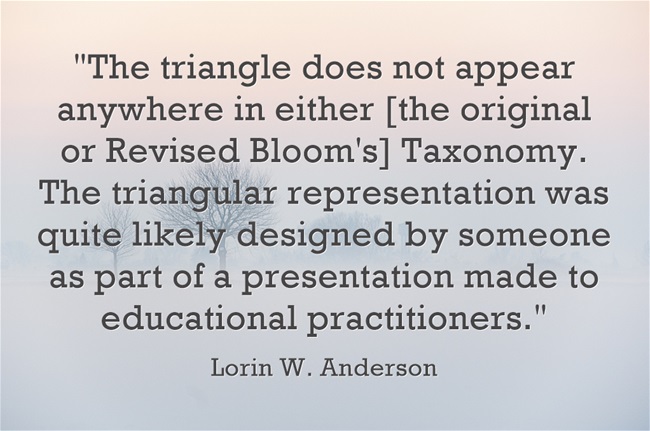Editor’s Note: Lorin W. Anderson, one of the co-authors of the Revised Bloom’s Taxonomy, left a comment on my post earlier this week, “Knowledge” & Bloom’s Pyramid. He graciously agreed to expand on this thought for this guest post. I’m adding it to The Best Resources For Helping Teachers Use Bloom’s Taxonomy In The....
Lorin W. Anderson received his Ph. D. from the University of Chicago in 1973, having studied with Benjamin S. Bloom. He spent 33 years on the faculty of the University of South Carolina, retiring in 2006. He currently holds the rank of Carolina Distinguished Professor Emeritus and is a member of the International Academy of Education.
1. The triangle does not appear anywhere in either Taxonomy. The triangular representation was quite likely designed by someone as part of a presentation made to educational practitioners (e.g., teachers, administrators). I believe that the triangular representation was developed in order to indicate that, in the original Taxonomy, the six categories formed a cumulative hierarchy. That is, it was believed by the authors of the original Taxonomy that mastery of each lower category was necessary before moving to the next higher category. For example, you have to comprehend something before you can apply it.
2. The triangular representation of the revised Taxonomy is particularly inappropriate for several reasons. First, the revised Taxonomy contains two dimensions, not one. The authors believed that knowledge was sufficiently important to be a separate dimension. They also believed there were different types or forms of knowledge: factual, conceptual, procedural, and metacognitive. Second, the nouns in the original Taxonomy were replaced by verbs, In this process, remember replaced knowledge at the lowest “level” of the second dimension, termed “cognitive processes.” If you read the text of the original Taxonomy, the equation of “knowledge” with “recall” and “recognition” is quite evident. Remember was followed by understand, apply, analyze, evaluate, and create. Third, the categories (verbs) in the cognitive process dimension did NOT form a cumulative hierarchy. Rather, they were considered to be “tools in a toolbox.” Thus, it was possible (and often quite useful) to apply in order to understand or to evaluate as you apply.
3. In your blog post, Dylan William’s representation, entitled “Bloom’s taxonomy, as it should be” is a far better representation of the revised Taxonomy than the triangular representation. In fact, if you change the nouns to verbs (other than knowledge), add Remember to the list in the upper row, and realize that knowledge is multi-faceted (as I mention above) he has almost reconstructed the two-dimensional table of the revised Taxonomy.
4. Finally, after 40+ years in the business, I am greatly dismayed that many educators get their information from oral presentations and secondary (and in some cases tertiary) sources. This practice tends to result in passing along half-truths and misinterpretations. In this regard, I think you could do a great service by directing the readers of your blog to original sources (even if they won’t read them). With respect to the revised Taxonomy, it would be helpful for anyone who is interested in writing about or making presentations on the revised Taxonomy to take 15 to 20 minutes to read the excellent overview written by David Krathwohl in the journal, Theory into Practice.

You need to be a member of School Leadership 2.0 to add comments!
Join School Leadership 2.0